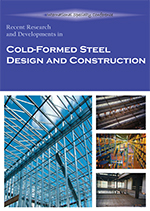Session Dates
24 Aug 2012 - 25 Aug 2012
Abstract
A 3D Finite Element (FE) model of steel sheeting, which includes the screw connector and support plate, is created to investigate the behavior of both steel sheeting and connections at elevated temperatures. The created model considers the material nonlinearity, large deformation and contact behavior. The material damage model for sheeting steel is defined so that the FE model is analyzed through the elastic and plastic ranges up to failure. The FE model is used to predict the ultimate resistance and deformation. The current FE model captures the main behavior of steel roof systems well up to around 20 minutes according to the test results from the literatures. The comparisons to the FE model with connector elements created previously show that the lower stiffness of connections reduces both the mid-span displacement up to 15 min and the compressive forces developed at support because of the restrained thermal elongation, which benefits both steel roof sheeting and connections at support. However, the current model needs to be improved in order to have the same final failure mode as from the test results from literatures.
Department(s)
Civil, Architectural and Environmental Engineering
Research Center/Lab(s)
Wei-Wen Yu Center for Cold-Formed Steel Structures
Meeting Name
21st International Specialty Conference on Cold-Formed Steel Structures
Publisher
Missouri University of Science and Technology
Document Version
Final Version
Rights
© 2012 Missouri University of Science and Technology, All rights reserved.
Document Type
Article - Conference proceedings
File Type
text
Language
English
Recommended Citation
Lu, W.; Mäkeläinen, P.; Outinen, J.; and Ma, Z., "Investigation of Behavior of Cold-formed Steel Sheeting Systems in Fire Using Finite Element Modeling" (2012). CCFSS Proceedings of International Specialty Conference on Cold-Formed Steel Structures (1971 - 2018). 4.
https://scholarsmine.mst.edu/isccss/21iccfss/21iccfss-session8/4
Investigation of Behavior of Cold-formed Steel Sheeting Systems in Fire Using Finite Element Modeling
A 3D Finite Element (FE) model of steel sheeting, which includes the screw connector and support plate, is created to investigate the behavior of both steel sheeting and connections at elevated temperatures. The created model considers the material nonlinearity, large deformation and contact behavior. The material damage model for sheeting steel is defined so that the FE model is analyzed through the elastic and plastic ranges up to failure. The FE model is used to predict the ultimate resistance and deformation. The current FE model captures the main behavior of steel roof systems well up to around 20 minutes according to the test results from the literatures. The comparisons to the FE model with connector elements created previously show that the lower stiffness of connections reduces both the mid-span displacement up to 15 min and the compressive forces developed at support because of the restrained thermal elongation, which benefits both steel roof sheeting and connections at support. However, the current model needs to be improved in order to have the same final failure mode as from the test results from literatures.



